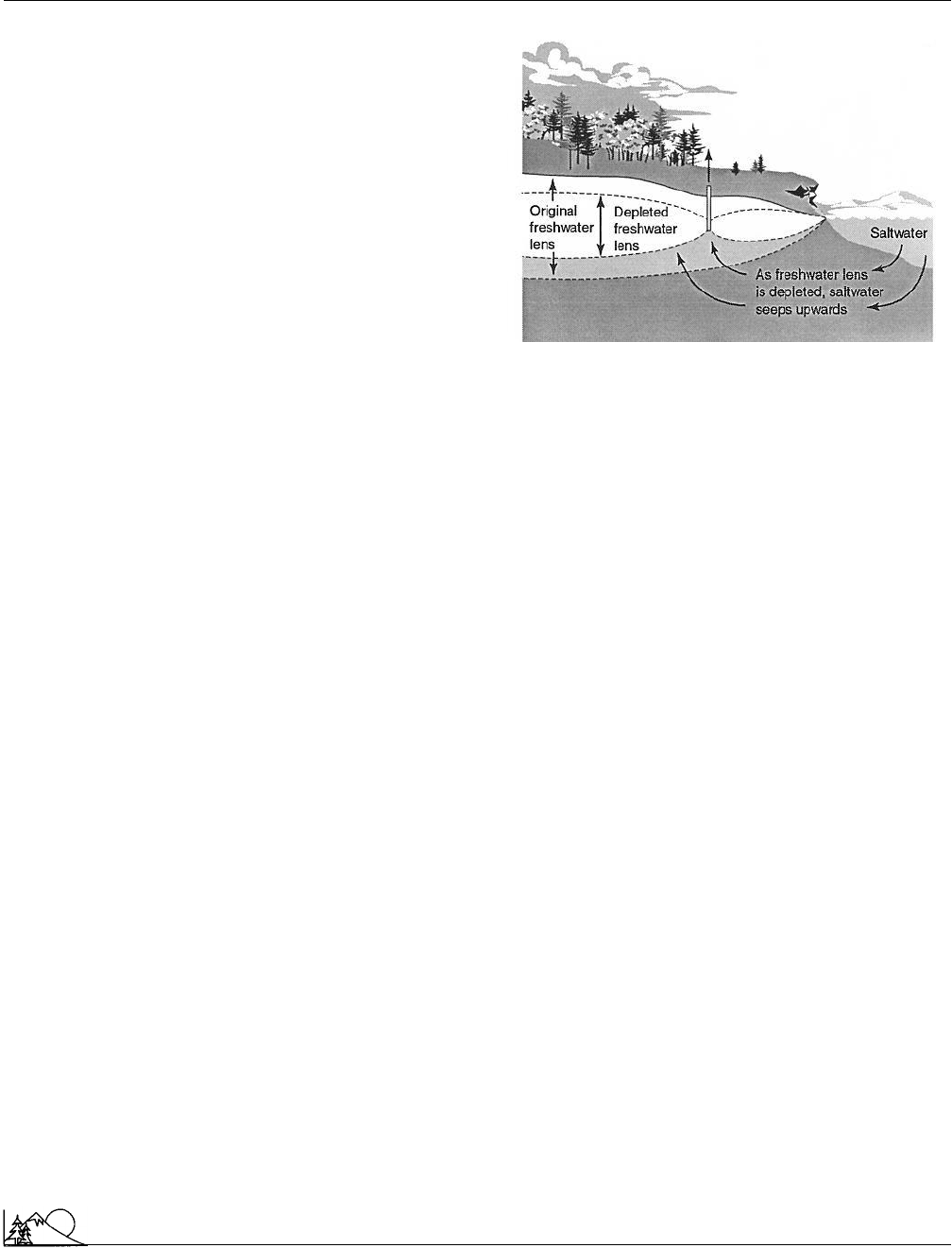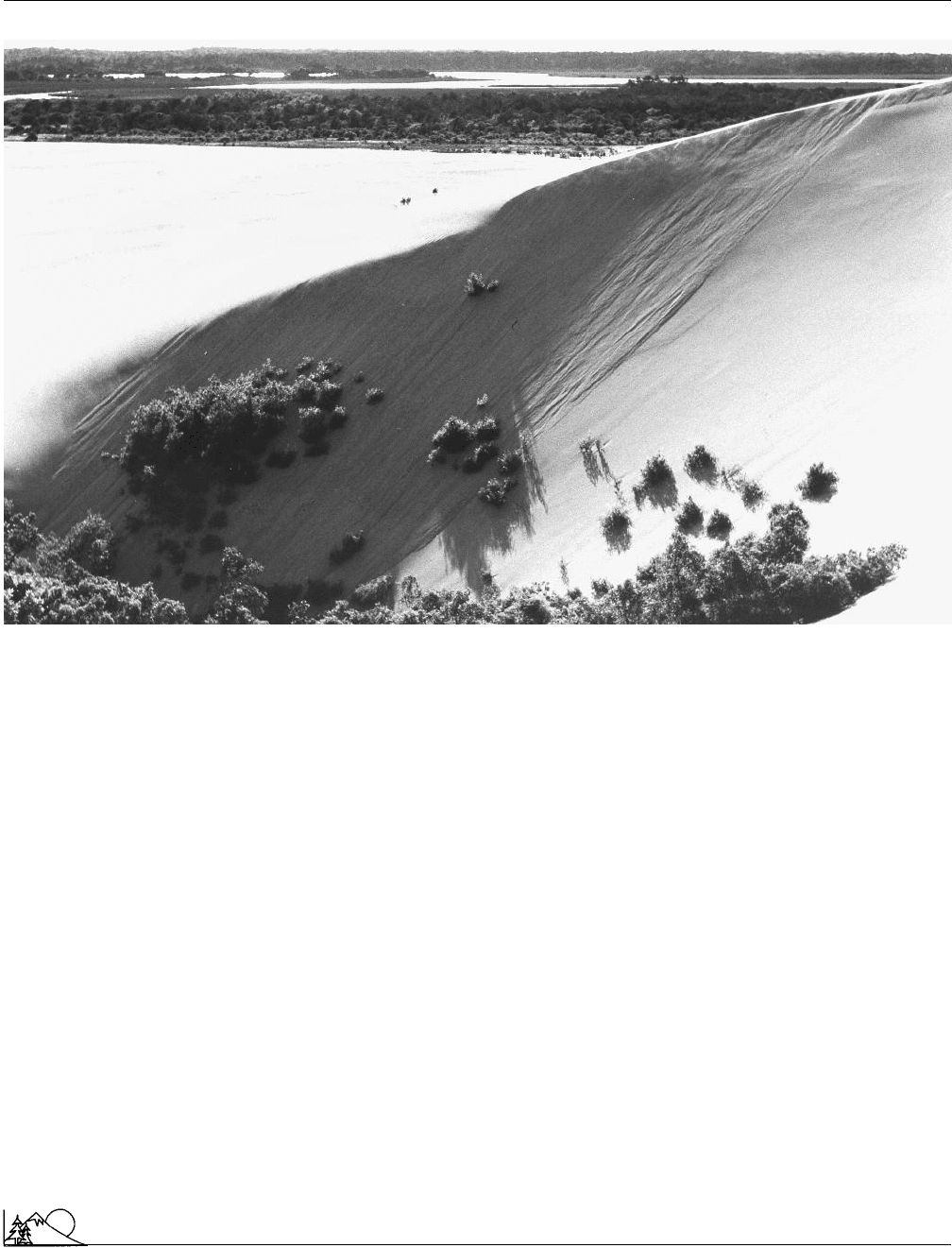Environmental Encyclopedia
Подождите немного. Документ загружается.


Environmental Encyclopedia 3
Salinity
ethics
had transformed the New World and contributed to
the modern environmental crisis. The result of this work was
Conquest of Paradise: Christopher Columbus and the Columbian
Legacy. One conclusion Sale reached in this book was that
the very cultures destroyed by the European invasion, those
of the Native Americans, had practiced many of the environ-
mental concepts to which modern societies must return if
the world is to survive.
Although Sale has expressed interest in writing novels,
his early books have been devoted to activist topics because
“the world is in such a mess, and it needs writing about.”
He continues: “I write my books to help save society and
the planet.”
[David E. Newton]
R
ESOURCES
B
OOKS
Sale, K. Dwellers in the Land: The Bioregional Vision. San Francisco: Sierra
Club Books, 1983.
———. Human Scale. New York: Coward, McCann & Geoghegan, 1980.
———. Rebels Against the Future: The Luddites and Their War on the
Industrial Revolution: Lessons For the Computer Age. Addison-Wesley, 1995.
———. The Conquest of Paradise. New York: Knopf, 1990.
———. The Fire of His Genius: Robert Fulton and the American Dream.
New York: Free Press, 2001.
———. The Green Revolution: The American Environmental Movement,
1962–1992. Hill and Wang, 1993.
P
ERIODICALS
Baker, J. F. “Kirkpatrick Sale.” Publishers Weekly (October 19, 1990): 41–42.
Saline soil
Soils containing enough soluble salts to interfere with the
ability of plants to take up water. The conventional measure-
ment that determines the
salinity
of
soil
is a deciSiemens
meter; soils are considered saline if the conductivity of their
saturation extract solution exceeds 4 deciSiemens meter-1.
This unit of measure closely approximates the ionic salt
concentration, and it is relatively easy to evaluate. The most
common salts are composed of mixtures of sodium, calcium,
and magnesium with chlorides, sulfates, and bicarbonates.
Other less soluble salts of calcium sulfate and calcium and
magnesium carbonate may be present as well. The
pH
is
commonly less than 8.5.
In saline soils, there is often what is known as a perched
water table—water close to the surface of the land. This
phenomenon can be caused by restricting layers of fine clay
within the soil, or by the application of waters at a rate
greater than the natural permeability of the ground. When
the
water table
is so close to the top of the soil, water is
often transmitted to the surface where evaporation occurs,
1237
leaving the ions in the water to precipitate as salts. The
resulting complex of salts can be seen on the surface of the
soil as a white, crust-like layer.
The surface layers of a saline soil commonly have very
good soil structure, and this is important to understand
if the soil is to be reclaimed or leached of the high salt
concentrations. This kind of structure has relatively large
pores; water can flow quickly through them, which aids in
carrying away salty water, thus making it easier to flush out
the soil. Artificial drains can also be installed beneath the
surface to provide an outlet for water trapped within the
soil, and once these drains are in place, salt concentrations
can be further reduced by the application of good quality
water.
Excessive
irrigation
and the use of fertilizers and ani-
mal wastes can all increase the salinity of soil. The yields of
common crops and the level of agricultural production are
severely reduced in areas where salts have been allowed to
accumulate in the soil.
Salinization
can be so severe in some
cases that only salt-tolerant crops can be grown.
Leaching
is often necessary to reduce the levels of salt and keep the
soil suitable for crop production. But this process can remove
other soluble components from the soil and carry them into
the
waste stream
, polluting both
groundwater
and sur-
face water. The
environmental degradation
from this
form of
agricultural pollution
can be extensive, and a
method needs to be developed for leaching saline soils with-
out these consequences. If this problem cannot be solved,
it will no longer be possible to use some saline soils for
agriculture. As
population growth
continues and the global
demand for food increases, another approach might be the
development of more salt-tolerant plant
species
.
[Royce Lambert and Douglas Smith]
R
ESOURCES
B
OOKS
Brady, N. C. The Nature and Properties of Soils. 13th ed. New York: Macmil-
lan, 2001.
Millar, R. W., and R. L. Danahue. Soils: An Introduction to Soils and Plant
Growth. 6th ed. Englewood Cliffs, NJ: Prentice-Hall, 1990.
Salinity
A salt is a compound of a metal with a nonmetal other than
hydrogen
or oxygen. NaCl (sodium chloride), or table salt,
is the best-known example. The solubility of various salts
in water at a standard temperature is highly variable. When
salts are dissolved in water, the result is called a saline solu-
tion, and the salinity of the solution is measured by its ability
to carry an electrical current. Salinity of water is one of the
components of
water quality
. Salinity is also measured

Environmental Encyclopedia 3
Salinization
in
soil
. Soil can become salinized from water containing
sufficient salts, from the natural degradation of soil minerals,
or from materials added to the soil such as
fertilizer
. Large
amounts of water may be required to leach the accumulated
salts from the root zone and prevent reduced plant growth
or plant desiccation. See also Soil profile; Water quality stan-
dards
Salinization
An increase in salt content, usually of agricultural soils,
irri-
gation
water, or drinking water is called salinization. Salini-
zation is a problem because most food crops, like the human
body, require fresh (nonsaline) water to survive. Although
a variety of natural processes and human activities serve to
raise the salt contents of
soil
and water, irrigation is the
most widespread cause of salinization. Almost any natural
water source carries some salts; with repeated applications
these salts accumulate in the soil of irrigated fields. In
arid
regions, streams, lakes, and even aquifers can have high
salt concentrations. Farmers forced to use such saline water
sources for irrigation further jeopardize the fertility of their
fields. In coastal areas, field salinization also results when
seawater floods or seeps into crop lands. This occurs when
falling water tables allow sea water to seep inland under
ground, or where
aquifer subsidence
causes land to settle.
Salinization also affects water sources, especially in arid re-
gions where evaporation results in concentrated salt levels
in rivers and lakes. Remedies for salinization include the
selection of salt-tolerant crops and flood irrigation, which
washes accumulated salts away from fields but deposits them
elsewhere.
Most of the world’s people rely on irrigated agriculture
for food supplies. Regular applications of water, either from
rivers, lakes, or underground aquifers, allow grain crops,
vegetables, and fruits to grow even in dry regions. California’s
rich Central Valley is an outstanding example of irrigation-
dependent agriculture. One of North America’s primary gar-
dens, the valley is naturally dry and sun baked. Canals car-
rying water from distant mountains allow strawberries, to-
matoes, and lettuce to grow almost year round. The cost of
this miraculous productivity is a gradual accumulation of
salts, which irrigation water carries onto the valley’s fields
from ancient sea bed sediments in the surrounding moun-
tains. Without heavy
flooding
and washing, Central Valley
soils would become salty and infertile within a few years.
Some of California’s soils have become salty and infertile
despite flooding. Similar situations are extremely widespread
and have been known since humankind’s earliest efforts in
agriculture. The collapse of early civilizations in Mesopota-
mia and the Indus Valley resulted in large part from salt
1238
accumulation, caused by irrigation, which made food sup-
plies unreliable.
Salts are a group of mineral compounds, composed
chiefly of sodium, calcium, magnesium, potassium, sulfur,
chlorine
, and a number of other elements that occur natu-
rally in rocks, clays, and soil. The most familiar salts are
sodium chloride (table salt) and calcium sulfate (gypsum).
These and other salts dissolve easily in water, so they are
highly mobile. When plenty of water is available to dilute
salt concentrations in water or wash away salt from soil,
these naturally occurring compounds have little impact.
Where salt-laden water accumulates and evaporates in basins
or on fields, it leaves behind increasing concentrations of
salts.
Most crop plants exposed to highly saline environ-
ments have difficulty taking up water and nutrients. Healthy
plants wilt, even when soil moisture is high. Leaves produced
in saline conditions are small, which limits the photosyn-
thetic process. Fruits, when fruiting is successful, are also
small and few. Seed production is poor, and plants are weak.
With increasing
salinity
, crop damage increases, until plants
cannot grow at all. Water begins to have a negative effect
on some crops when it contains 250–500
parts per million
(ppm) salts; highly saline water, sometimes used for irriga-
tion out of necessity, may contain 2,000–5,000 ppm or more.
For comparison, sea water has salt concentrations upwards of
32,000 ppm. In soil, noticeable effects appear when salinity
reaches 0.2%; soil with 0.7% salt is unsuitable for agriculture.
Another cause of soil salinization is subsidence. When
water is pumped from underground aquifers, pore spaces
within rocks and sediments collapse. The land then com-
pacts, or subsides, often lowering several meters from its
previous level. Sometimes this
compaction
brings the land
surface close to the surface of remaining
groundwater
.
Capillary action pulls this groundwater incrementally toward
the surface, where it evaporates, leaving the salts it carried
behind in the soil. Near coastlines such processes can be
especially severe. Seawater often seeps below the land surface,
especially when fresh-water aquifers have been depleted.
When seawater, with especially high salt concentrations,
rises to the surface it evaporates, leaving crystalline salt in
the soil.
In such cases, the salinization of the aquifer itself is also
a serious problem. Many near-shore aquifers are threatened
today by seawater invasions. Usually seawater invasions occur
when farms and cities have extracted a substantial amount
of the aquifer’s water volume. Water pressure falls in the
fresh-water aquifer until it no longer equals pressure from
adjacent sea water. Sea water then invades the porous aquifer
formation, introducing salts to formerly fresh water supplies.
Rivers are also subject to salinization. Both cities and
farms that use river water return their
wastewater
to the

Environmental Encyclopedia 3
Salinization
river after use. Urban storm sewers and
sewage treatment
plants often send poor quality water back to rivers;
drainage
canals carry intensely saline
runoff
from irrigated fields back
to the rivers that provided the water in the first place. When
dams
block rivers, especially in dry regions, millions of
cubic meters of water can evaporate from reservoirs, further
intensifying in-stream salt concentrations.
The
Colorado River
is one familiar example out of
many rivers suffering from artificial salinization. The Colo-
rado, running from Colorado through Utah and Arizona,
used to empty into the Sea of Cortez south of California’s
Imperial Valley before human activities began consuming
the river’s entire
discharge
. Farms and cities in adjacent
states consume the river’s water, adding salts in wastewater
returned to the river. In addition, the Colorado’s two huge
reservoirs, Lake Powell and Lake Mead, lie in one of the
continent’s hottest and driest regions and lose about 10% of
the river’s annual flow through evaporation each year. By
the time it reaches the Mexican border, the river contains
850 ppm salts, too much for most urban or agricultural uses.
Following a suit from Mexico, the United States government
has built a $350 million
desalinization
plant to restore the
river’s
water quality
before it leaves Arizona. The Colora-
do’s story is, unfortunately a common one. Similar situations
abound on major and minor rivers from the Nile to the
Indus to the Danube.
Salinization occurs on every occupied continent. The
world’s most severely affected regions are those with arid cli-
mates and long histories of human occupation or recent intro-
ductions of intense agricultural activity. North America’s
Great Plains, the southwestern states, California, and much
of Mexico are experiencing salinization. Pakistan and north-
western India have seen losses in agricultural productivity, as
have western China and inland Asian states from Mongolia
and Kazakhstan to Afghanistan. Iran and Iraq both suffer
from salinization, and salinization has become widespread in
Africa. Egypt’s Nile valley, long northern Africa’s most boun-
tiful bread basket, also has rising salt levels because of irriga-
tion and subsidence. One of the world’s most notorious case
histories of salinization occurs around the
Aral Sea
, in south-
ern Russia. This inland basin, historically saline because it
lacks an outlet to the sea, is fed by two rivers running from
northern Afghanistan. Since the 1950s, large portions of these
rivers’ annual discharge has been diverted for cotton produc-
tion. Consequently, the Aral Sea is steadily drying and shrink-
ing, leaving great wastes of salty, dried sea bottom. Dust
storms crossing these new deserts carry salts to both cotton
and food crops hundreds of miles away.
Avoiding salinization is difficult. Where farmers have
a great deal of capital to invest, as in California’s Central
Valley and other major agricultural regions of the United
States, irrigators install a network of perforated pipes, known
1239
as tiles, below their fields. They then flood the fields with
copious amounts of water. Flooding washes excess salts
through the soil and into the tiles, which carry the hypersa-
line water away from the fields. This is an expensive method
that wastes water and produces a toxic brine that must be
disposed of elsewhere. Usually this brine enters natural rivers
or lakes, which are then contaminated unless their volume
is sufficient to once again dilute salts to harmless levels.
However this method does protect fields. More efficient
irrigation systems, with pipes that drip water just near plant
roots themselves may be an effective alternative that contam-
inates minimal volumes of water.
Water can also be purified after agricultural or urban
use. Purification, usually by reverse osmosis, is an expensive
but effective means of removing salts from rivers. The best
way to prevent water salinization is to avoid dumping urban
or irrigation wastes into rivers and lakes. Equally important
is avoiding evaporation by reconsidering large dam and
res-
ervoir
developments. Unfortunately, most societies are re-
luctant to consider these options: reservoirs are widely viewed
as essential to national development, and wastewater purifi-
cation is an expensive process that usually benefits someone
else downstream.
Perhaps the best way to deal with salinization is to find
or develop crop plants that flourish under saline conditions.
Governments, scientists, and farmers around the world are
working hard to develop this alternative. Many wild plants,
especially those native to deserts or sea coasts, are naturally
adapted to grow in salty soil and water. Most food plants
on which we now depend—wheat, rice, vegetables, fruits—
originate in nondesert, nonsaline environments. When do-
mestic food plants are crossed with salt-tolerant wild plants,
however, salt-tolerant domestics can result. This process was
used to breed tomatoes that can bear fruit when watered
with 70% seawater. Other vegetables and grains, including
rice, barley, millet, asparagus, melons, onions, and cabbage,
have produced such useful crossbreeds.
Equally important are innovative uses of plants that
are naturally salt tolerant. Some salt-adapted plants already
occupy a place in our diet—beets, dates, quinoa (an Andean
grain), and others. Furthermore, careful allocation of land
could help preserve remaining salt-free acreage. Planting
salt-tolerant fodder and fiber crops in soil that is already
saline can preserve better land for more delicate food crops,
thus reducing pressure on prime lands and extending soil
viability. See also Salinization of soils
[Mary Ann Cunningham Ph.D.]
R
ESOURCES
B
OOKS
Frenkel, H., and A. Meiri, eds. Soil Salinity: Two Decades of Research in
Irrigated Agriculture. New York: Van Nostrand Reinhold, 1985.

Environmental Encyclopedia 3
Salinization of soils
National Research Council. Saline Agriculture. Washington, DC: National
Research Council, 1990.
Scabocs, I. Salt-Affected Soils. Boca Raton, FL: CRC Press, 1989.
Shainberg, I., and J. Shalhevet. Soil Salinity Under Irrigation. Berlin:
Springer-Verlag, 1984.
Salinization of soils
Salinization
of
soil
involves the processes of salt accumula-
tion in the upper rooting zone so that many plants are
inhibited or prohibited from normal growth. Salinization
occurs primarily in the semi-arid and
arid
portions of the
earth. Salinization is commonly thought to occur only in
the hot climatic regions, but may be found in cooler to cold
portions of the earth where precipitation is very limited.
Where the annual precipitation exceeds about 20 inches (500
mm), there is usually adequate downward movement of salts
through
leaching
to prohibit the development of
saline
soil
. Occasionally salinization of soil will occur where there
has been an inundation of land by sea water. Some areas of
the world were once under sea water, but due to uplift the
land is now many feet above sea level. These lands are
common sources of “ancient salts” and may lead to the devel-
opment of saline waters as these soils are slowly leached.
Natural sources of salts in soil are primarily from the
decomposition
of rocks and minerals through the processes
of chemical
weathering
. With adequate amounts of mois-
ture present, hydrolysis, hydration, solution, oxidation, and
carbonation cause the minerals to decompose and release the
ionic constituents to form various salts. The more common
cations are sodium, calcium, and magnesium with lesser
amounts of potassium and boron. The common anions are
chloride and sulfate with lesser amounts of bicarbonate, car-
bonate, and occasionally nitrate.
Inherent factors of the landscape may also lead to
salinization of soils. One of the more common factors is the
restriction of water
drainage
within the soil, often referred
to as soil permeability. Soil becomes less
permeable
because
of genetic or inherited layers within the
soil profile
that
have relatively high amounts of clay. Because of the extremely
small sizes of the clay particles, the natural pore size is also
very small, frequently being less than 0.0001 mm average
diameter. The natural tortuosity and small size combine to
severely reduce the rate of water movement downward which
tends to increase salt buildup.
In addition, because of the soil pore size, saline waters
may be transported upward through the processes of capillary
action. While the rate of upward movement of water may
be relatively slow, the process can deliver saline water from
several inches below the surface of the land and create a
zone of highly saline soil at the surface of the earth.
1240
Salinization of soils has also occurred in areas where
irrigation
waters have been applied to lands that have not
been subject to long-term natural leaching by rainfall. In
several cases the application of relatively good quality water
to arid soils with poor internal drainage has caused the soil
to develop a higher
water table
which in turn has permitted
the salts within the soil to be carried to the surface by high
evaporation demand. In other cases water of relatively high
salt content has been applied to soils without proper drain-
age, resulting in the development of saline soils. As the water
is evaporated from the soil or the plant surfaces, the salts
are left to accumulate in the soil.
Because of the increasing demand for food and fiber,
many marginal lands are being brought into agronomic pro-
duction. Proper irrigation management and drainage deci-
sions must be considered on a worldwide and long-term
basis to avoid a deleterious influence on the ability to produce
on these soils and to determine the appropriate environmen-
tal considerations for disposal of salts from salinized soils.
See also Arable land; Nitrates and nitrates; Runoff; Soil con-
servation; Soil eluviation; Soil illuviation
[Royce Lambert]
R
ESOURCES
B
OOKS
Foth, H. D. Fundamentals of Soil Science. 7th ed. New York: Wiley, 1984.
Singer, M. J., and D. N. Munns. Soils: An Introduction. 5th ed. New York:
Macmillan, 2001.
O
THER
Richards, L. A., ed. Diagnosis and Improvement of Saline and Alkali Soils.
USDA Handbook 60. Washington, DC: U.S. Government Printing Of-
fice, 1964.
Salmon
Salmon is a popular fish for food and sport fishing. Five
species
of salmon live in the North Pacific Ocean: Pink,
Sockeye, Coho, Chum, and Chinook. One species, the At-
lantic salmon, lives in the North Atlantic Ocean. Two other
fish species that are also members of the Salmonidae fish
family—steelhead and sea-run cutthroat trout—live in the
Pacific Northwest. The Pacific Coast salmon populations
are being threatened with extirpation from much, if not all,
of their range.
At the heart of the Pacific salmon species’ range, and
perhaps indicative of the heart of its problems, is the Colum-
bia River basin. Covering parts of seven states and two
Canadian provinces, the Columbia River system contains
over 100
dams
, 56 of which are major structures, including
19 major generators of hydroelectric power. These structures
present an insurmountable obstacle for these migrating

Environmental Encyclopedia 3
Salmon
fishes. Adult salmon, after growing and maturing in the
ocean, return to the freshwater stream of their origin as they
swim upstream to spawn. The adults will die shortly after this
culmination of their arduous journey, and, after hatching,
the young salmon—called smolts—swim downstream to the
ocean to continue this life cycle.
About three-fourths of all of the population declines
of salmon are directly attributable to hydroelectric dams.
The dams simply do not allow a majority of these fish
to successfully complete their
migration
, and many salmon
die as they swim, or are swept, directly into the turbines.
Fish ladders, stepped pools intended as an aid for fish
to bypass the dams, enable some salmon to continue their
journey, but many do not find their way through. As
they move downstream, the smolts are slowed or stopped
by the reservoirs created by the dams. Here they are
exposed to larger populations of predators than in their
natural riverine
habitat
. They are exposed to a wide
variety of pathogens as well as a physical
environment
of warmer, slow moving waters, to which they are only
moderately tolerant. Only 20% of the downstream migrants
ever make it to the Pacific. Poor
water quality
and
nutrient
deficits in many stretches of the Columbia River
also takes a toll on the young smolts.
Overfishing
, both offshore and along the rivers, con-
tributes to the decline of salmon populations. Fishery biolo-
gists have attempted to offset these losses of native stocks
by releasing hatchery-raised salmon. However, interbreeding
reduces the genetic hardiness of these fish. They also weaken
the genetic lines of wild fish when they breed with them.
Historically, when hatchery programs have increased the
mixed stock fish population (i.e., wild and farmed) dramati-
cally, fishing activity increases and a further depletion of
wild salmon results.
To address overfishing issues, in 1996 Washington
State began using a mass-marking program designed to en-
able fishermen to more easily identify hatchery chinook and
coho salmon. Fish bred in a hatchery have their adipose fin
(a small tail fin) removed before they are released. Anyone
who catches a marked hatchery fish may keep it; wild salmon
that are unmarked must be released back into the wild.
Realizing the need for a more balanced management
plan for the Columbia River basin, Congress passed the
Northwest Power Act in 1980. This act established the
Northwest Power Planning Council (NWPPC), which was
charged with the task of balancing long-term hydroelectric
energy needs with minimizing the negative impact of dams
on native salmon populations. However, despite modifica-
tions to water flow along the Snake and Columbia Rivers
instituted by the NWPPC, the native salmon population
continued to decline throughout the 1980s.
1241
In 1991, the National Marine Fisheries Service
(NMFS) began an extensive study of salmon populations in
the northwestern United States. The NMFS found that
52 distinct populations (termed Evolutionarily Significant
Units, or ESUs) of Pacific salmon have been identified in
west coast states. That same year, Snake River stocks of
sockeye salmon were first listed under the
Endangered Spe-
cies Act
(ESA) as endangered. Twenty-six salmon ESUs
are now listed as threatened or endangered status.
In June 2000, the NMFS adopted a rule prohibiting
the killing or injuring of 14 ESUs of Pacific salmon and
steelhead classified as threatened under the Endangered
Species Act (ESA). This “take” rule was adopted under
section 4(d) of the ESA. The rule does allow for the
removal of ESA-listed salmon in association with approved
programs such as scientific research and tribal fishing
rights.
Various species of salmon have been added to the ESA
list in the past several decades. As of May 2002, Atlantic
salmon were included on the ESA with an endangered status,
while chum and coho were listed as threatened. Dual status
ESA species (endangered in one part of their range and
threatened in another) include chinook salmon, sockeye
salmon, and steelhead.
In late 2001, a U.S. district court ruled that the
NMFS listing of Oregon coast coho salmon as endangered
was “arbitrary and capricious” (Alsea Valley Alliance v.
Evans). The court determined that excluding hatchery
stock from the population assessment of this species, as
NMFS had done, was inappropriate. This ruling could
have far-reaching implications for other salmon stocks
listed as endangered or threatened; after the Alsea ruling,
six delisting petitions were filed by farming
irrigation
groups and other agencies requesting the removal of addi-
tional ESUs from endangered status. As of May 2002,
NMFS was appealing the Alsea decision, but had also
announced status reviews on fourteen endangered salmon
ESUs. The Oregon coho remains on the endangered list
pending the decision of the appeal.
Long-term, sustained population recovery for these
ecologically, as well as economically, important salmon pop-
ulations will depend on changes in both habitat and human
behavior. More water is needed downstream to aid migra-
tion. This would mean less water for irrigation and for
hydroelectric-generated power. Increased water flow
through releases from reservoirs and spillway openings in
the hydroelectric dam system has been shown to improve
salmon survival rates in the Snake River. Balancing the power
requirements of the Pacific Northwest with the habitat needs
of salmon species will be a key part of ensuring their contin-
ued survival.
[Eugene C. Beckham and Paula A. Ford-Martin]

Environmental Encyclopedia 3
Henry S. Salt
R
ESOURCES
B
OOKS
Lichatowich, Jim. Salmon Without Rivers: A History of the Pacific Salmon.
Washington, DC: Island Press, 2001.
Taylor, Joseph. Making Salmon: An Environmental History of the Northwest
Fisheries Crisis. Seattle, WA: University of Washington Press, 2001.
P
ERIODICALS
Curtis, S. “Power Plan Trumps Salmon Recovery.” Field & Stream 106,
no.1 (May 2001): 16.
Gresh, Ted, J. Lichatowich, and P. Schoonmaker. “An Estimation of
Historic and Current Levels of Salmon Production in the Northeast Pacific
Ecosystem.” Fisheries 25, no.1 (January 2000): 15–21.
O
THER
Northwest Fisheries Science Center, National Marine Fisheries Service.
Salmonid Travel Time and Survival Related to Flow in the Columbia River
Basin. March 2000 [cited May 2002]. <http://www.nwfsc.noaa.gov/pubs/
nwfscpubs.html>.
Northwest Salmon Recovery Planning. [cited May 31, 2002]. <http://re-
search.nwfsc.noaa.gov/cbd/trt/index.html>.
O
RGANIZATIONS
Northwest Fisheries Science Center, NMFS, NOAA, 2725 Montlake
Blvd. E, Seattle, WA USA 98112 (206) 860-3200, Email:
NWFSC.Webmaster@noaa.gov, <http://www.nwfsc.noaa.gov/>
Henry S. Salt (1851 – 1939)
English writer and reformer
Although he is probably best known as the vegetarian author
of Animals’ Rights Considered in Relation to Social Progress
(1892), Henry Salt was a man with many roles—teacher,
biographer, literary critic, and energetic advocate of causes he
grouped under the title of humanitarianism. These included
pacifism and socialism as well as
vegetarianism
, anti-vivi-
sectionism, and other attempts to promote the welfare of
animals. Late in his life, Salt also advocated efforts to con-
serve the beauties of
nature
, especially wildflowers and
mountain districts.
Salt was born in India in 1851, the son of a colonel
in the Royal Bengal Artillery. When his parents separated
a year later, Salt’s mother moved to England, and he spent
much of his childhood at the home of her well-to-do parents.
Educated at Eton and Cambridge, he embarked on an appar-
ently comfortable career when he returned to Eton as an
assistant master. While teaching at Eton, however, Salt met
some of the leading radicals and reformers of the day, includ-
ing William Morris, John Ruskin, and George Bernard
Shaw, with whom he formed a lasting friendship. During
this period Salt became a vegetarian. He also read
Henry
David Thoreau’s
Walden, which inspired Salt and his wife
to leave Eton and move to a country cottage in 1885 to lead
a simple, self-sufficient life. For Salt, the simple life was far
from dull. He became a prolific writer, although his efforts
brought little financial profit. In addition to Animals’ Rights,
1242
his works include a biography of Thoreau, studies of Shelley
and Tennyson, a translation of Virgil’s Aeneid, and an autobi-
ography, Seventy Years Among Savages (1921), in which he
examined English life as if he were an anthropologist study-
ing a primitive tribe. Another book, A Plea for Vegetarianism,
came to the attention of
Mohandas Karanchand Gandhi
when he was a student in London. Gandhi, who was raised
a vegetarian, later wrote in his Autobiography that Salt’s book
made him “a vegetarian by choice.” Salt apparently met
Gandhi in 1891, then corresponded with him in 1929 during
Gandhi’s nonviolent struggle for the independence of In-
dia—a struggle inspired, in part, by Thoreau’s essay, “Civil
Disobedience.”
Perhaps the best statement of Salt’s views is the address
he wrote to be read at his funeral. Declaring himself “a
rationalist, socialist, pacifist, and humanitarian,” Salt disa-
vowed any belief “in the present established religion,” but
acknowledged “a very firm religious faith” in “a Creed of
Kinship:” “a belief that in years yet to come there will be a
recognition of the brotherhood between man and man, na-
tion and nation, human and sub-human, which will trans-
form a state of semi-savagery...into one of civilization, when
there will be no such barbarity as warfare, or the robbery of
the poor by the rich, or the ill-usage of the lower animals
by mankind.”
[Richard K. Dagger]
R
ESOURCES
B
OOKS
Hendrick, G., and W. Hendrick, eds. The Savour of Salt: A Henry Salt
Anthology. Fontwell, Sussex: Centaur Press, 1989.
P
ERIODICALS
Jolma, D. J. “Henry Salt and 100 Years of Animal Rights.” The Animals’
Agenda (November–December 1992): 30–2.
Salt marsh
see
Wetlands
Salt (road)
While several
chemicals
are available for deicing winter
roads, common salt (NaCl) is most frequently used. Approxi-
mately 20 billion lb (9 billion kg) of salt are used each year
in the United States for treating ice and snow on roads.
Calcium chloride (CaCl
2
), potassium chloride (KCl), and
urea are also available but used in smaller quantities. Com-
mon salt is preferred because it is cheaper per pound and
more effective. While the price per pound of salt is cheap,
about 1.5 billion dollars are spent per year on the enormous
quantity used, and its distribution and application.

Environmental Encyclopedia 3
Salt water intrusion
Salt in its solid form does not melt ice. It first must
go into solution to form a brine, and the brine effects a
melting of ice and snow. Ordinarily, snow is packed on the
road surface by vehicular traffic; known as the “hard-pack,” it
forms a bond with the underlying pavement that is frequently
impossible to remove with snowplows. Salt melts through
the hard-pack and breaks the ice-pavement bonding. Traffic
breaks the loosened ice, and snowplows are then able to
remove the broken ice and packed snow. Deicing facilitates
traffic movement after a snow fall and it is thought to make
winter driving safer.
But there are hidden costs in the use of salt. It corrodes
steel, and it is estimated that about three billion dollars is
spent annually to protect vehicles from rust with corrosion-
resistant coatings. Some have added to this estimate the
costs of frequent washings to save vehicles from rust. The
expense of salt deicing does not stop, however, with motor
vehicle protection and damage. The United States has about
500,000 bridges, of which an estimated 40% are currently
considered deficient. Damage to bridges comes from a vari-
ety of causes, but many experts consider the most significant
agent for premature deterioration is deicing salt. It is esti-
mated that repair and protection to damaged bridges in the
United States in the next decade will cost between one-half
and two-thirds of a billion dollars. Salt damage is also causing
bridges in Great Britain to deteriorate more rapidly than
expected and is believed to be the principal cause of bridge
damage with an anticipated cost of repair in the next decade
of a half billion pounds.
Salt damages roadside vegetation, and it has been
shown that waters downstream from a deiced highway con-
tain significantly more (in one case 31 times as much) chlo-
ride than waters in the same rivers upstream. Well water
can similarly become contaminated with salt, and both Mas-
sachusetts and Connecticut have large numbers of
wells
with a sodium content in excess of 20 mg per liter, which
is considered to be the upper limit for individuals who must
control sodium intake. One area of Massachusetts has quit
using deicing salt because of concern for sodium in their
drinking water.
It would be useful to develop a deicer that has less
impact on the economy and the
environment
. One such
alternative is calcium magnesium acetate (CME) which,
while initially far more costly than salt, is believed to have
less potential for damaging the environment. See also Auto-
mobile; Groundwater pollution; Salinity; Salinization
[Robert G. McKinnell]
R
ESOURCES
P
ERIODICALS
Boice, L. P. “Environmental Management: CMA, An Alternative to Road
Salt?” Environment 28 (1985): 45.
1243
Saltwater intrusion into a coastal aquifer due
to depletion of the freshwater in the aquifer.
(Illustration by Hans & Cassidy.)
“Deicing Agents: A Primer.” Public Works (July 1991): 50–51.
Dunker, K. F., and B. G. Rabbat. “Why America’s Bridges Are Crumbling.”
Scientific American 268 (March 1993): 66–72.
“Highway Deicing: Comparing Salt and Calcium Magnesium Acetate.”
TR News 163 (November–December 1992): 17–19.
Reina, P. “Salt Breaks the Back of Motorway Bridges.” New Scientist (April
29, 1989): 30.
Salt water intrusion
Aquifers in coastal areas where fresh
groundwater
is dis-
charged into bodies of salt water such as oceans are subject
to salt water intrusion. Intrusion occurs when water usage
lowers the level of freshwater contained in the
aquifer
. The
natural gradient sloping down toward the ocean is changed,
resulting in a decrease or reversal of the flow from the aquifer
to the salt water body, which causes salt water to enter and
penetrate inland. If salt water travels far enough inland well
fields supplying freshwater can be ruined and the aquifer
can become so contaminated that it may take years to remove
the salt, even with fresh groundwater available to flush out
the saline water.
Salt water intrusion can also develop where there is
artificial access to salt water, such as sea level canals or
drainage
ditches. On the coastal perimeter of the United
States there are a number of areas with such intrusion prob-
lems. There are five methods available to control intrusion:
1) the reduction or rearrangement of the pumping draw-
down; 2) direct recharge; 3) the development of a pumping
trough adjacent to the coast; 4) maintenance of a freshwater
ridge above sea level along the coast; and 5) construction of
artificial subsurface barriers.

Environmental Encyclopedia 3
Sand dune ecology
Developing a pumping trough or maintaining a pres-
sure ridge are methods that do not solve the basic problem:
the overdraft or excessive withdrawal of water from the
aquifer. Only when this problem is solved by reducing draw-
down, or isolated by the subsurface barrier method, can the
intrusion be stopped or reversed. In some areas, it is simply
not economically feasible to control intrusion.
Oceanic islands, such as Hawaii, have unique problems
with salt water intrusion. Most islands consist of sand, lava,
coral, or limestone; they are relatively
permeable
, so fresh-
water is in contact with salt water on all sides. Because fresh
water is supplied entirely by rainfall in these places, only a
limited amount is available. A freshwater lens is formed by
movement of the freshwater toward the coast. Depth to salt
water at any location is a function of rainfall recharge, the
size of the island, and permeability. Tidal and seasonal fluc-
tuations may form a transition zone between freshwater and
salt water.
The close proximity of salt water in oceanic islands can
introduce saline water into fresh groundwater even without
excessive overdraft. An island well pumping at a rate high
enough to lower the
water table
disturbs the fresh-salt
water equilibrium, and salt water then rises as a cone within
the well. To avoid this condition, island
wells
are designed
for minimum drawdown, and they skim freshwater from the
top of the aquifer. In general, drawdowns of a few inches
to a few feet provide plentiful water supplies.
[James L. Anderson]
R
ESOURCES
P
ERIODICALS
Gorrie, P. “Water From the Ground.” Canadian Geographic 112 (Septem-
ber–October 1992): 68–77.
Wagman, D. “Protecting Hidden Assets: Many American Cities and Coun-
ties Are Designing Groundwater Regulations to Protect Underground Aq-
uifers.” American City and County 105 (March 1990): 38–41.
Sand dune ecology
Dunes
are mounds of sand that have been piled by the action
of winds. The sand is usually composed of bits of minerals
that have been eroded from rocks, picked up by water or
winds, and then re-deposited somewhere else. Typically, the
sand is deposited behind some object that is a barrier to the
movement of air currents, which causes the windspeed to
slow suddenly so that the load of sand particles can no longer
be contained against the force of gravity, and it falls to the
ground. If there is a suitable source of sand, dunes may
deposit along the edges of oceans, large lakes, rivers, and
even in inland locations.
1244
The mineralogical composition of sand in dunes varies
greatly from place to place. The most common minerals are
quartzitic (this is a silica sand), but other minerals may also
be mixed in, and they may dominate the composition of the
sand in some places. The White Sands National Monument
in New Mexico, for example, is characterized by a sand of
gypsum (calcium sulfate). The grain size of sands varies
depending on the strength of the winds that delivered the
sand to the location where the dune has formed—the greater
the typical windspeed, the larger the sand grains can be.
Once deposited to the surface, unconsolidated sand
tends to be moved about and shifted by the winds. In fact,
dunes tend to “migrate” in the direction of the prevailing
winds, with sand being picked up at the windward side of
the dune, and deposited on the leeward side. Because of the
mechanical instability of their surface young dunes initially
provide rather precarious habitats for the establishment of
vegetation. However, if plants do manage to establish a
foothold on a dune, the progressive development of vegeta-
tion over time will help to stabilize the surface, allowing an
ecosystem
to develop through the process of
succession
.
Some of the most extensive dune systems in the world
occur in deserts, including parts of the Sahara
Desert
of
northern Africa, the Gobi Desert of eastern Asia, and the
Great Western Desert of the United States and Mexico.
Because of the aridity of those environments only a very
limited amount of ecological development is possible. In
places with a more moderate
climate
, however, sand dunes
can be colonized by vegetation and succession can proceed
to the development of tall, mixed-species forests. This type
of succession is typical of many dune systems along the
coasts of the oceans and many large lakes and rivers of North
America.
Environmental conditions
Sandy soils are generally free-draining, so that even
in regions with abundant rainfall sand-dune habitats can be
quite
arid
. The dry
soil
conditions are made worse by the
frequently windy conditions in dune habitats, a factor that
speeds the evaporation of water from plant foliage and the
soil surface. Droughty conditions are especially important
on the higher parts of dunes; in low places the
water table
may come to the surface, creating locally moist or wet condi-
tions, which are sometimes referred to as dune slacks.
In addition, most sands contain few nutrients, so they
provide rather infertile conditions for plant growth. Sandy
soils are also lacking in organic matter, which prevents them
from holding much water or nutrients for later uptake by
plants. In fact, some sand-dune habitats can be referred to
as ombrotrophic, or “fed from the clouds,” which means that
atmospheric deposition
is the principal source of
nutrient
inputs in support of plant productivity. In addition, the low
levels of calcium concentrations make sandy soils highly

Environmental Encyclopedia 3
Sand dune ecology
Moving sand dunes are slowly engulfing a forest in Nags Head, North Carolina. (Photograph by Jack Dermid. National
Audubon Society Collection/Photo Researchers Inc. Reproduced by permission.)
vulnerable to
acidification
, a condition that can be stressful
to some
species
of plants.
Vegetation of sand dunes
The species of plants that grow on sand dunes vary
depending on the climate, the
stability
of the dunes, soil
chemistry, and
biogeography
. Dunes of the deserts of
southern California, southwestern Arizona, and nearby
Mexico are sparsely vegetated with a mixture of perennial
grasses, such as Pleuraphis rigida, perennial herbs such as
the sand sagebrush (Artemisia filifolia), and species of shrubs,
including ephedra (Ephedra trifurca), daleas (Dalea spp.),
Colorado desert buckwheat (Eriogonum deserticola), and mes-
quite (Propsis spp.). During occasional rainy periods these
sandy deserts can bloom prolifically with showy annual herbs,
such as species of Allionia, Boerhavia, Euphorbia, Oenothera,
and Pectis. Areas of gypsum-rich sand have other species
that are specific to that soil type, including yucca (Yucca
elata), ephedra (Ephedra torreyana), onion blanket (Gaillardia
multiceps), and grasses such as Bouteloua breviseta.
In more humid climatic regimes of North America,
younger sand-dune systems are initially colonized by species
1245
of dune-grasses, such as American beach grass (Ammophila
breviligulata), sea oats (Uniola paniculata), sand rye (Elymus
mollis), and beach grass (Calamovilfa longifolia). As the dunes
stabilize, other species invade the community. These may
form a
prairie
with interspersed shrub- and tree-dominated
nuclei, which may eventually coalesce to form continuous
forest (see the next section on dune succession). Some dune-
rich areas of the east coast of the United States support forests
of pines (Pinus spp.), oaks (Quercus spp.), and magnolia
(Magnolia virginiana). Older dunes in the
Great Lakes
region tend to be covered by mixed stands of oaks, pines,
and tulip-tree (Liriodendron tulipifera). The inland sand hills
of northern Alberta are commonly occupied by stands of
jack pine (Pinus banksiana).
Primary succession on sand dunes
Succession on recently formed sand dunes is a type of
primary succession. This is because the sandy substrate that
is newly exposed for ecological development has no pre-
existing biological capability to initiate the succession. Suc-
cession can not begin until
microbes
, plants, and animals
have invaded the site from existing ecosystems somewhere

Environmental Encyclopedia 3
Sanitary sewer overflows
else. (Secondary succession occurs after a disturbance, but
one that has allowed some of the original biota to survive,
so they can play a prominent role in ecological recovery.)
Some classic studies of primary succession have in-
volved sand-dune ecosystems. In North America, the most
famous studies were conducted on systems of dune ridges
at several places on Lake Michigan and Lake Huron. Dune
ridges are actively developing in those places to this day.
This occurs as sand is piled up onto the beach by wave
action, to be moved inland by the prevailing on-shore winds
and mostly deposited on the dune closest to the edge of the
lake, on its leeward, or building side. This process of dune-
building is an ancient phenomenon, and it has been actively
occurring in the region since deglaciation, more than twelve
thousand years ago.
The dune building is, however, superimposed upon
another geological process—the slow rebounding in eleva-
tion of the regional ground surface, a phenomenon that is
known as isostasy. This slow, uplifting process is still oc-
curring in response to the long-ago melting of the continen-
tal glaciers that once covered virtually all of northern North
America; when the glaciers were present, their enormous
weight actually depressed crustal bedrocks beneath them into
Earth’s plastic mantle. The surface has been rebounding
since deglaciation released the crust from the weight of the
gigantic glaciers, at a fairly steady rate of about 1 yd (1 m)
per century. Because of isostatic rebound, ancient shorelines
of the Great Lakes are now higher in elevation than they
used to be, and in some flatter areas well-defined dune
systems formed on ancient shores can be found miles inland
of the present shoreline of the lakes. These circumstances
mean that dunes located further inland are older than dunes
occurring closer to the modern lake shores. Because the ages
of the various dunes can be dated, ecologists are able to
study a series of dunes of various age and their associated
communities. This so-called chronosequence technique
allows the ecologists to reconstruct the basic elements of the
successional process.
The first plants to colonize the embryonic dunes are
annual and biennial plants of shoreline habitats, such as the
American searocket (Cakile edentula), Russian thistle (Salsola
kali), orache (Atriplex patula), and a small euphorb (Eurphor-
bia polygonifolia). Although buffeted by severe weather, these
plants help in the initial stages of dune stabilization. The
next invaders of the site are several species of dune grasses,
particularly Ammophila breviligulata and Calamovilfa longi-
folia. The extensive roots and rhizomes of these grasses are
important in binding the sandy substrate, and in stabilizing
the lakeward dune ridges and allowing them to grow larger.
Once these grasses take hold, some other foredune plants
can establish and begin to grow, including the beach pea
(Lathyrus maritimus) and evening primrose (Oenothera
1246
biennis). With time, a tall grass prairie develops, dominated
by various species of grasses and broad-leaved herbs. The
prairie becomes invaded by shade-intolerant shrub and tree
species, which form forest nuclei. Eventually a climax forest
develops that is dominated by oaks, pines, and tulip-tree.
[Bill Freedman Ph.D.]
R
ESOURCES
B
OOKS
Barbour, M. G., and W. D. Billings. North American Terrestrial Vegetation.
Cambridge, UK: Cambridge University Press, 1988.
Ranwell, D. S. Ecology of Salt Marshes and Sand Dunes. Chapman and Hall,
London, 1972.
P
ERIODICALS
Morrison, R. G., and G. A. Yarranton. “Diversity, Richness, and Evenness
during a Primary Sand Dune Succession at Grand Bend, Ontario,” Canadian
Journal of Botany 51 (1973): 2401–2411.
Olson, J. S. “Rates of Succession and Soil Changes on Southern Lake
Michigan Sand Dunes.” Botanical Gazette 119 (958): 125–170.
Sanitary landfill
see
Landfill
Sanitary sewer overflows
Sanitary sewer overflows (Ssos) are discharges of untreated
sewage from municipal sanitary sewer systems that were
not designed to carry storm-water
runoff
. Almost all sewer
systems experience at least occasional Ssos and they occur
frequently in some systems. Ssos are a major source of
water
pollution
in lakes, rivers, and streams. Although they are
illegal under the
Clean Water Act
, the U.S.
Environmental
Protection Agency
(EPA) estimates that at least 40,000
Ssos occur annually nationwide.
Of the approximately 50 trillion gal (189 trillion l) of
raw sewage that flow daily through about 19,500 sewer sys-
tems in the United States, it is estimated that about 1.2
billion gal (4.5 billion l) were released in Ssos in 2000. This
raw sewage is discharged from manholes, bypassing pump
stations and treatment plants. It flows into basements, lawns,
streets, parks, streams, swimming areas, and drinking water.
It is estimated that sewers back up into basements 400,000
times a year in the United States.
Ssos pose a serious threat to human health and to the
environment
. Raw sewage can introduce disease-causing
organisms into drinking water and swimming and fishing
areas. People may swallow contaminated water or eat con-
taminated fish or shellfish. Diseases also can be contracted
by breathing in organisms from sewage or by
absorption
through the skin. Although most such illnesses are mild
